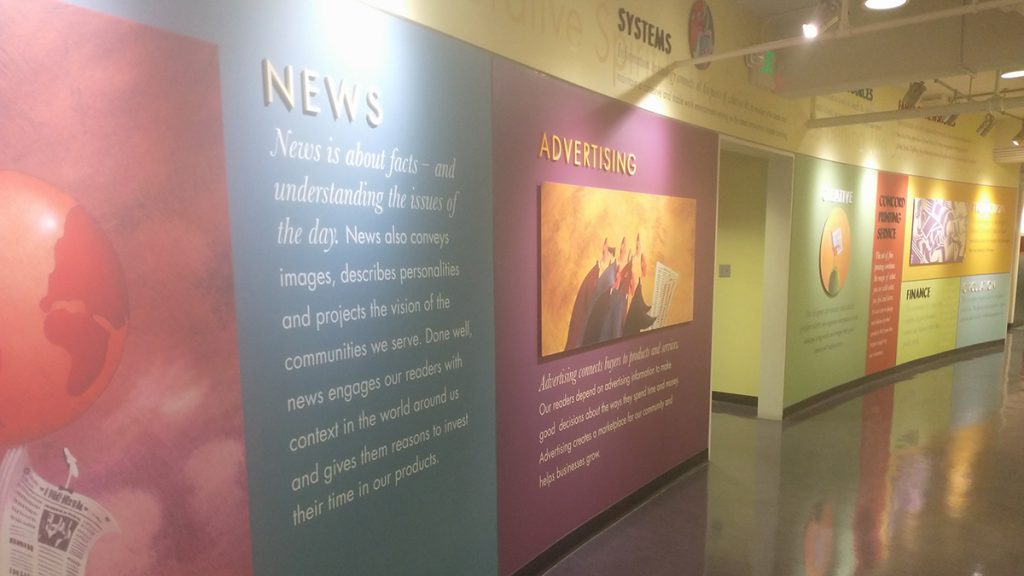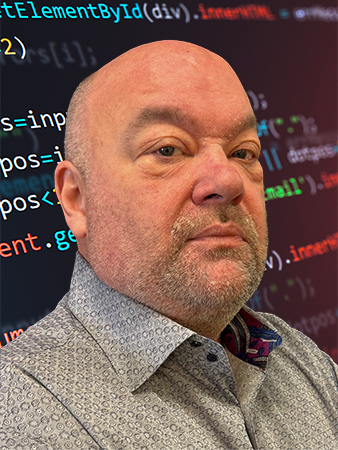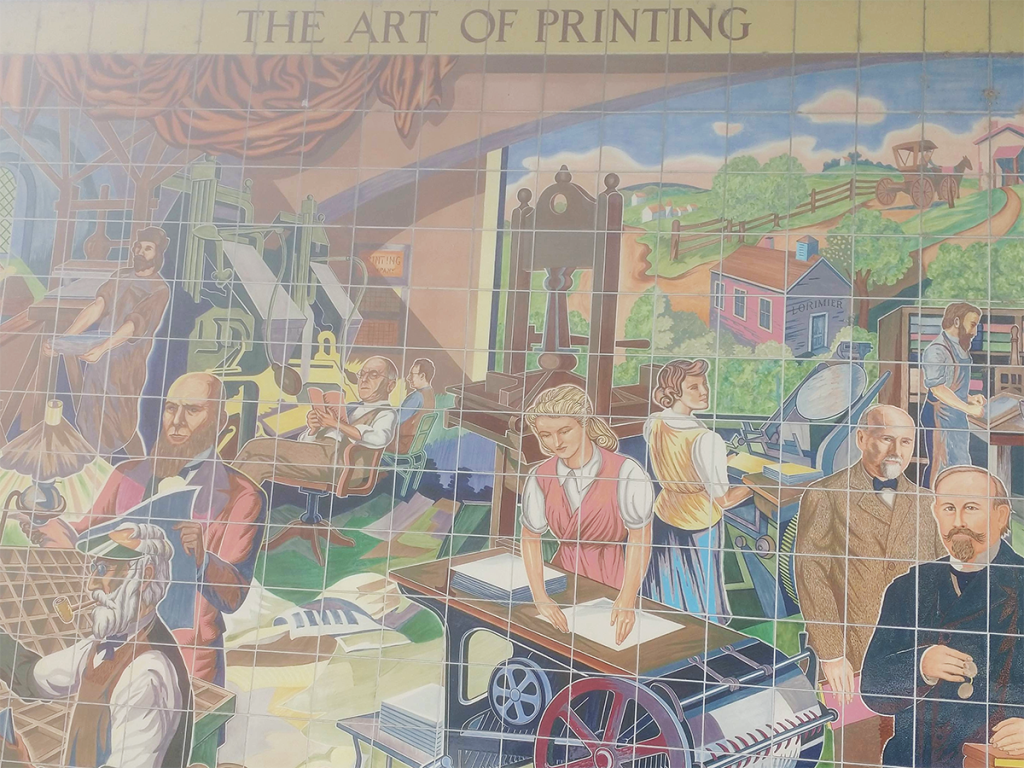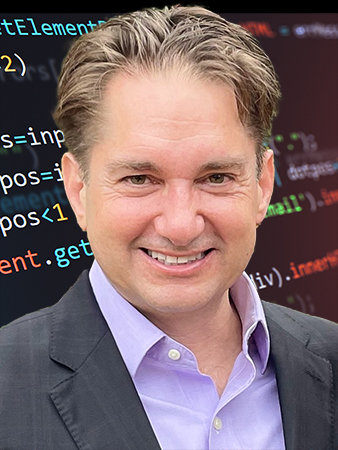
A wall inside the Southeast Missourian's offices showcases the newspaper's values.
A leap forward for AI in journalism is coming from an unexpected place — small-town Missouri
This article is part of “AI is here,” a series from RJI highlighting AI innovation in journalism. Read more here.
The AI revolution first reared its head more than two years ago with the release of ChatGPT, which sent shockwaves through a news industry eager not to miss the boat on the next big thing. Since then, as machine-learning technology’s adoption by news organizations has proceeded in fits and starts, a gulf has emerged.
Small, community-focused news organizations all over the country have already been dealing with aging hardware, staffing constraints and economic realities that make experimentation difficult, and the rise of AI threatens to push them further behind the curve. At the same time, many of the country’s largest news organizations have acknowledged the need to invest in AI but have proceeded cautiously, keeping much of their experimentation out of public view.
Public-facing AI innovation, then, has largely remained in the domain of Silicon Valley, as was the case during the advent of the internet — an example many in the industry point to as a cautionary tale in which news organizations were unaccountably slow to embrace the next frontier of media.
But more than 2,000 miles away from Silicon Valley in Cape Girardeau, Missouri, a family-owned network of news outlets seems determined to prove that it isn’t too late for local journalism to take charge of its digital destiny.
Rust Communications encompasses 15 newspapers across five states, though most are located in Missouri. Almost all of them, from the Town Courier in rural Blytheville, Arkansas, to the flagship Southeast Missourian in Cape Girardeau, Missouri, now use a content management system (CMS) that one might expect to find in Silicon Valley or at a high-powered national media conglomerate.
You’ve likely heard that AI tools can generate headline suggestions, produce accurate summaries and ensure that all elements of a given story are SEO-friendly. Others can analyze a journalist’s notes and spot an important angle that even an experienced reporter missed in their write-up. Still others can generate illustrative images, determine which article would be best to feature on the homepage or scan an outlet’s news archives to learn the stylistic and grammatical rules it needs to follow.
Many news outlets have taken bits and pieces of these capabilities and attempted to gently massage them into their workflows. Rust Communications’ CMS does them all, it does them well, and it’s all powered by PubGen.AI, a system built by a sister company to its newspapers. In the first three months after Rust launched the CMS across its newspaper network, the publications saw an average 30-45% lift in online traffic. Digital-only subscriptions have grown in a range from 16-37%.
“The performance of this CMS is ridiculously high compared to what’s out there in the industry. It’s all created to use AI in the most positive way because it’s tuned to journalism.”
Jon K. Rust, president of Rust Communications
“The performance of this CMS is ridiculously high compared to what’s out there in the industry,” said Jon K. Rust, president of Rust Communications. “It’s all created to use AI in the most positive way because it’s tuned to journalism.”
Readers would be forgiven for dismissing Rust’s optimism as a marketing pitch — indeed, now that the CMS has been rolled out to the company’s newsrooms, it is also being sold to news organizations — but this reporter was given firsthand demonstrations of its capabilities, and “compared to what’s out there,” the difference is stark.
Image generation, for example, is not the comedy of errors that anyone who has tried to “engineer” an image prompt will be familiar with. Parents of toddlers, especially, will be happy to find that Rust’s image generator does not make them feel like their work is at the mercy of a toddler-level intelligence. The various forms of SEO and drafting assistance flow together seamlessly and swiftly, without the need to switch back and forth between a smorgasbord of tools from different sources. (For now, the only exception is a third-party tool for crafting page layouts, though that task, too, will eventually become integrated into the CMS.)
But perhaps most impressively of all, even the network’s most grizzled veterans of news writing and editing are not put off by thematic suggestions from their robot helper, an editing tool staff affectionately call “Eddie” (Its public-facing version is a conversational chatbot that appears as a pop-up on the Southeast Missourian’s website).

Rick Fahr, editor of the Southeast Missourian, is one such staffer. Aside from being a veteran in two senses — he has served as a columnist, editor and publisher over the course of three decades in the business, and he served on two tours of military duty overseas following 9/11 — he is also verifiably grizzled: Like a hard-nosed baseball player from the 1920’s, he spits tobacco juice into an ever-present water bottle that sits by his computer as he puts together each day’s edition. But when it comes to AI, he is ready to leave the dead-ball era.
“I have a reporter out there who used to be editor of the paper, so he’s been doing this for 30 years just like I have,” Fahr said. “Even he finds Eddie useful, because he’ll write a story and think he has a good handle on it, but it’ll give him a suggestion and he’ll say, ‘You know, I didn’t even think about that.’ I didn’t have any resistance from reporters thinking that this could replace them as a reporter. It’s there to make sure they don’t miss anything.”
Fahr said the system does more than check for missing pieces of the story — it also alerts reporters when a story displays more nuanced biases or blind spots that result in the omission of an important perspective.
Fahr emphasized that the CMS’s utility as an assistant for reporters is more than just a parroting of the party line for an industry that doesn’t want to spook its journalists. It has demonstrated real value for one of community journalism’s most enduring challenges: making the most of the available talent in markets that typically see young professionals move on after a few years (that is, if they are willing to work in a rural town at all).

“Their interviewing skills might not be where we would like for them to be,” he said. “This thing is really good at generating interview questions. And every now and then, when we’re between reporters at, say, our little newspaper in Marble Hill, Missouri, the publisher can use this tool to fill in some of the gaps.”
That striking combination of small-town news and sophisticated technology reflects a rare combination of flavors: The family ownership, once almost ubiquitous, that has declined in the industry as local news deserts have expanded, paired with the deep pockets more typical of a mass media company.
But for Jon Rust, there is no juxtaposition — only a consistent dedication to the Cape Girardeau community and other small Midwestern towns. And lest it be said that he doesn’t walk the walk, he still lives in an apartment above the flagship newspaper’s offices.

“We really want local media to survive and to succeed because that will help communities thrive,” Rust said. “Local media has always played a role in helping to create community identity and reflect it. We’re missing that in a lot of places in this country right now.”
The community and family-focused ethic also imbues the company with built-in longevity. Gary Rust, who founded the company in 1967, died in January, exactly three years and one day after the death of his son and Rust Communications co-president Rex Rust. That another son of the family patriarch still runs the company is only a hint of the depth in the family’s ranks.
In fact, it’s the third generation that has led the AI charge. Sho Rust, Gary’s grandson, left a successful career in Los Angeles as design lead for Boston Consulting Group’s Digital Ventures — in addition to learning to deploy generative AI for eight years and, previously, working on computer effects and promotional campaigns for the blockbuster Marvel film, “The Avengers” — and returned to Cape Girardeau to found PubGen. His return to his roots has informed his view on what AI can do in a community-centered setting.
His return to his roots has informed his view on what AI can do in a community-centered setting.
“I realized the legacy of a newspaper isn’t just my grandfather or the newspaper itself, it’s all the stories that are in there, too,” Sho Rust said. “It’s almost like a museum of the stories and history of this community. I very much wanted to be a part of that.”
“Local media has always played a role in helping to create community identity and reflect it. We’re missing that in a lot of places in this country right now.”
Jon K. Rust, president of Rust Communications
That sentiment became quite literal in the context of PubGen. While the AI has been fed specific rules and information to guide its operation, much of the context it draws from has been gathered from integrating the archives into the AI, sometimes to the surprise of Fahr and his reporters.
“I had a new reporter here use Eddie to help with a story about the upcoming Christmas parade, and when they turned the story in, there was historical information about the grand marshals of the parade,” Fahr said. “I thought it was really interesting, and it wasn’t information that we would have had in a normal parade preview. Come to find out it was all true, and we wouldn’t have known about it if Eddie didn’t have all that archival material at its fingertips. I can tell such a difference in the depth of contextual information that we just didn’t have before.”
The Rusts see another, more indirect benefit, given that human editors are necessary to ensure any errors introduced by the AI don’t make it into the final article. They believe the importance placed on these editors in the drafting process will make content better in an age when a 24-hour news cycle, industry-wide staffing shortages and an over-reliance on automated editing have produced an evident laxity in proofreading standards in the name of speedy production.
“The quality of content just becomes so much more important in the age of AI,” said Sho Rust, noting that the influence of the archives on PubGen has added further impetus for Rust newsrooms to ensure they publish content with a consistent level of polish. “A lot of our newsrooms are going through a kind of cleaning process.”
Of course, “content” is a word with many meanings in the digital world; for the Southeast Missourian, it includes a conversational AI chatbot that takes the form of a pop-up window both on the newspaper’s homepage and on article pages. As aforementioned, it is essentially the public-facing version of Eddie, but instead of advising reporters, it helps audiences with questions about articles or community issues.
Jon Rust has already seen the chatbot make a difference — he recalls a local chamber of commerce meeting about a proposed hike in water rates, during which community members said they didn’t have enough information to make a decision. He pointed them to the chatbot, which listed recent stories – and analysis – about the issue.
Another popular prompt is “local implications,” which summarizes why a given story should matter to a local resident.
That’s fitting for a company, and a family, that has built its news brand on the power of “local implications.” Just as fitting is the way Sho Rust, once again a local resident himself, sees the future of AI, the future of Rust Communications and the future of close-knit community life in much the same light.
“I’m not going to let the torch die on my watch,” he said.
Cite this article
Fitzgerald, Austin (2024, Feb. 21). A leap forward for AI in journalism is coming from an unexpected place — small-town Missouri. Reynolds Journalism Institute. Retrieved from: https://rjionline.org/news/a-leap-forward-for-ai-in-journalism-is-coming-from-an-unexpected-place-small-town-missouri/

